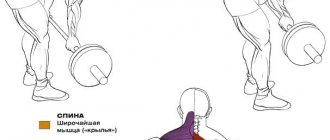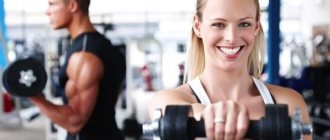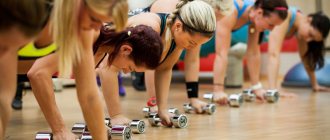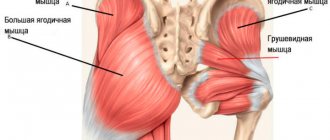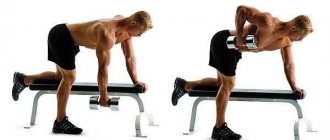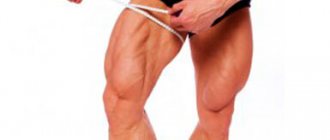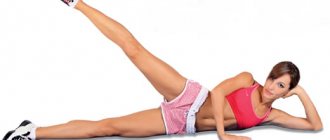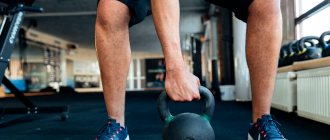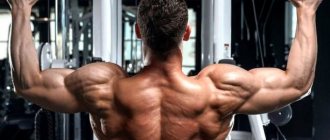- October 28, 2018
- Workouts in the gym
- Nikita Novikov
Standing calf raises are perhaps the main and most popular exercise for training the calf muscles. The beauty of this movement is that it can be performed by both professional athletes and beginner athletes. Standing calf raises seem like a very simple exercise, and there is nothing supernatural about doing it. In fact, even such a seemingly simple movement has its pitfalls and nuances. In our article we will talk about them in detail.
Anatomy
Before we tell you about the technique of performing calf raises in a machine, with a barbell or dumbbells, we would like to share information about which muscles this movement loads.
This exercise is aimed at working the triceps surae muscle. The calf and soleus muscles receive the target load. The gastrocnemius (biceps muscle) is attached to the femur by two bundles. The soleus is located under the gastrocnemius muscle and has one attachment bundle. Performing 1-2 calf exercises (such as standing calf raises and seated calf raises) once a week will create the right training stress for your calf growth.
What muscles work
In fitness complexes, various variations of calf raises are used to strengthen and increase the volume of the calves and correct the silhouette of the lower leg; this exercise mainly trains the gastrocnemius and the soleus muscles that frame it.
The initial position of the feet from which the lift is performed can correct the impact on the muscles: if the toes are spread out to the sides, the load falls on the outer side of the muscles, if the toes are brought inward and are closer to each other than the heels, the inner side of the calf muscle is trained.
To ensure an even load in the starting position, the feet should be placed parallel. To train the soleus muscles of the lower leg, calf raises are performed from a sitting position.
To increase efficiency, the calf raise exercise is performed with dumbbells. It can also be complicated by increasing the range of motion of the foot when lifting using low steps and elevations.
Raising on your toes with a transition to your heels and alternating walking in these two positions is one of the traditional exercises for strengthening the muscles of the foot, for the prevention of varicose veins, arthritis and other pathologies of the ankle joint.
But such exercises must be used with great caution in the strength training regime with many repetitions and weights. This exercise can aggravate Achilles tendon and ankle injuries.
With caution and only after consultation with specialists, you can practice this movement in the presence of even weak signs of varicose veins. Methods for performing calf raises in the simulator are shown in the photo.
The degree of difficulty of this exercise can vary as the area of contact of the sole of the foot changes during the lift. So, to maintain the highest possible lift with a narrow area of contact between the toe and the support, special training is needed.
Lifting technique
To practice calf raise techniques, exercise equipment, barbells, and dumbbells are used.
Various exercise machines allow you to fix the body, removing the weight from the legs and increasing the effectiveness of muscle stretching. Special pedestals are also used to increase the range of motion.
- At home, you can do lifts with the toes supported by a block, discs from a barbell, or adapt any other small stable elevation for this.
When performing calf raises using a pedestal, you need to comfortably fix your hands. The legs can be slightly bent at the knees, the back is straight and slightly tilted forward.
With dumbbells
When making the exercise heavier, lifting onto your toes from a standing position, dumbbells should be held in your arms down along your body.
You can vary the exercise by performing it for each leg separately, while you can take heavy weights, leaning your free hand on the back of a chair or wall. You can simply perform the exercise on one leg, placing the entire weight of your body on it.
Weightening calf raises in a seated position is done by placing dumbbells, a container of water or sand, or a barbell disc on the knees.
With a barbell
The barbell exercise is one of the most difficult and only experienced athletes can do it. Not only the lower leg works here, but also the muscles of the entire body.
The feet are positioned shoulder-width apart, the athlete grabs the bar and lifts the barbell by weight, beginning a movement called a “dead snatch.” Then you need to slowly rise on your toes and fix this position.
Weighting and smooth, measured exercises with fixation on the rise for several seconds helps to increase muscle volume. To increase strength and tone, faster and longer repetitions are needed.
- Lifts performed for training purposes are done in 3-4 approaches, 20 or 10 multiple sets. They are usually part of strength training and are performed after warming up.
- Advice when performing calf raises at home: If the goal is to increase the volume of your calves, you need to perform calf raises in equal proportions from a sitting and standing position.
The position also determines which muscles work during movement.
- In a sitting position (when the leg is bent at a right angle at the knee), the soleus is predominantly loaded.
- In a standing position – calf.
Stop placement
Also, due to holding a dumbbell, the shoulders and trapezius are partially loaded.
Separately, the stereotype about foot positioning should be touched upon. Some athletes believe that changing the position (toes turned out or pointed inwards) of the feet can shift the load on certain muscles. However, this is an error that goes against basic anatomy. The position of the feet does not change the load on the calves.
Lifting in the simulator while standing
To perform calf raises in a standing machine, there is a so-called calf machine. Its main advantage is that it allows you to fix the body in one position. This makes it possible to load our calves in a more isolated manner, without involving third-party muscle groups in the work. The trajectory of movement is very simple, so you will be able to specifically work the target muscles.
The exercise is performed as follows:
- Take the starting position: adjust the machine to your height. Then rest your shoulders against the support rollers. Place your feet on the platform so that your heels can rise and fall normally.
- Inhaling, slowly lower yourself down, stretching your Achilles tendon and calves.
- As you exhale, press your body upward with a powerful movement. Stay in this position for a couple of seconds, feeling the maximum tension in the muscles.
- Repeat the movement as many times as you need.
We have already dealt with standing calf raises in the simulator, but now let’s look at other varieties of this exercise. We are, of course, talking about exercises with dumbbells and a barbell.
Standing calf raise with barbell
This version of the exercise is the most difficult, so it is more suitable for experienced athletes. It is recommended to perform it as a basic movement at the beginning of the complex on the calf muscles.
Technique:
- Hang the number of weights on the barbell with which you feel comfortable performing the exercise, and place it on the floor.
- Come close to the apparatus, grab the bar with an overhand grip and lift the barbell as if you were doing a deadlift. The weight, of course, should be less than what you use for deadlifts.
- While in this position, exhale and press your body upward. At the top point you need to take a short pause.
- As you inhale, lower your body down.
- Do the number of repetitions you need.
If you're worried about your back or just don't feel comfortable performing a standing calf raise with the barbell in this position, you can do this movement with the barbell on your shoulders, just like a squat. Below we will post a video that shows this implementation option in detail.
Useful tips
In addition to exercises that allow you to make your calves smaller, it’s a good idea to listen to the advice given by experienced athletes.
- If you play sports in equipped gyms and at the same time strive for slimmer and toned legs, it would be better not to put a lot of stress on them. Pumped calves look voluminous.
- If you want to reduce the volume of your shins, it is better to pay special attention to stretching them. Sports such as Pilates, gymnastics or yoga give similar results.
- Aerobic exercise and jumping rope will also help tone your calf muscles.
- Also, home exercises for losing weight in your legs will be more effective if you control your diet. It is not necessary to resort to radical changes in your diet, but it is advisable to adjust your habits. You need to think through the menu for the day to make it balanced, and also not allow yourself to eat at night.
- The main rule is to strive for regularity and follow the correct technique when performing exercises. Following this advice, within a month you can notice changes for the better.
Lifting with dumbbells
The calf exercise - standing calf raise - is not as difficult as the previous one, so it is great for beginners and girls.
This exercise should be done like this:
- Take dumbbells, keep your hands at your sides and straighten your back. Stand with your toes on a slight elevation to increase your range of motion.
- As you exhale, press your body with your toes up.
- Inhaling, lower it to the original position.
- Repeat the movement several times.
If this exercise is very easy for you, try doing it for each leg separately.
Training skinny legs
For too thin legs, you can add the following exercise to other exercises, which will help you gain the necessary muscle mass by training at home.
Standing straight and lowering your hands down, you need to raise your toes, remaining standing only on your heels. We smoothly shift the weight and stand on our toes. Then we repeat this movement only on one leg, then on the other. This exercise is performed about 15 times for each approach. This is done three times. You can take dumbbells in your hands.
Tips for implementation
To make the standing calf raise exercise even more effective, we suggest you familiarize yourself with the following recommendations.
- As with other exercises, you need to work with fairly heavy weights. The main thing is not to overdo it; choose a weight with which you can lower and rise at least 10 times, while still feeling the necessary load in your calves.
- Do the exercise with full range of motion. This is the only way you can achieve maximum reduction.
- At the top point, do not bend your knees too much. This will transfer the load from your upper body to your knee joints. Tension in the hips and a slight bend in the knees will create the muscle damper necessary for the joints.
- If your fitness center does not have a calf machine, and all the barbells and dumbbells you need are occupied, then feel free to use a Smith machine. Place a special stand or two plates under your feet, which will create the necessary elevation. In the Smith machine, calf raises are performed in the same way as calf raises with a barbell on the shoulders.
- For each calf exercise, do 3 sets of 10-15 reps each.
How to make exercise more effective: 10 tips
For the training to bring maximum benefit, you need to adhere to the following recommendations:
- The range of motion should be full and the movements themselves should be controlled.
- Watch the position of your back and legs throughout the exercise.
- The ascent should be made to the highest possible point with a delay there for several seconds
- At the starting point, you need to lower your heel as low as possible, stretching your calves.
- Don't feel sorry for yourself: choose the maximum weight and number of repetitions.
- To avoid injury with heavy weights, use a weightlifting belt.
- Avoid performing the element if you have lower back pain.
- Don’t forget about breathing: when rising, inhale, when lowering, exhale.
- Perform the element at least 15-20 times in three approaches.
- Don't forget to pre-warm up your muscles before performing the element.
Basic mistakes
We have already understood the technique and features of calf raises, now let's look at the most common mistakes athletes make when training these muscles.
- No warm-up. Calves, like any other muscles in our body, need to be warmed up well before starting a sports activity. Before you start working your calves, do 2-3 sets of bodyweight calf raises. Then perform 1-2 warm-up sets with light weights on the exercise you choose. Only after this entire procedure is it recommended to start working weights. Using the same principle (1-2 warm-up sets, followed by 3-4 working sets), you should warm up other muscles in your body.
- Insufficient time for rest. Any experienced athlete will tell you that the calf muscles are among the most resilient in our body. They are loaded every day when we run, walk or just stand. That is why they need to be trained hard and intensively. But even these muscles need time to rest. If you train them every day, sooner or later their growth will simply stop due to the fact that you did not allow them to recover.
- Poor execution technique. The results and the health of his joints depend on how the athlete performs the exercise. Very often, beginners resort to “cheating” - jerking and other sudden movements. With this technique, third-party muscle groups are included in the work, which “eat up” most of the load. To prevent this from happening, all exercises must be done very technically.
Nuances to consider
To make standing calf raises more effective, the following aspects should be taken into account when performing them:
- To work this muscle group, you will need to perform from 3 to 5 approaches, which include 15-20 repetitions.
- It is recommended to use a medium weight, because if you overload yourself, it will be impossible to do a sufficient number of repetitions, and this is what determines the effectiveness of the exercise. But underweight will not load the muscles as much as necessary.
- Make sure that your back does not arch, and that your shoulders, pelvis and heels remain in line. Also, the head should not “nod”. All movements are concentrated in the ankle area.
- The muscles will receive an even greater load if the amplitude is maximum. You should strive to lower your heels as low as possible and raise your heels as high as possible.
- It is important to monitor proper breathing; if you forget about it, it will be more difficult to keep your spine straight.
- In order not to damage the tendons, it is necessary to lower smoothly, and the heavier the load, the more careful the downward movements should be. Lifting up can be more powerful and even sharp, the main thing is to tighten the lower leg muscles more strongly.
- Take a short break every time you reach the highest point. This stop creates additional stress.
- It is not necessary to linger at the bottom, but it can be done if at the same time you want to stretch your muscles. You shouldn't stop at the bottom if you're training with heavy weights.

